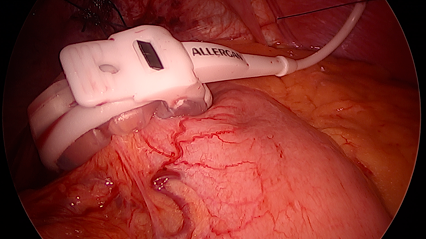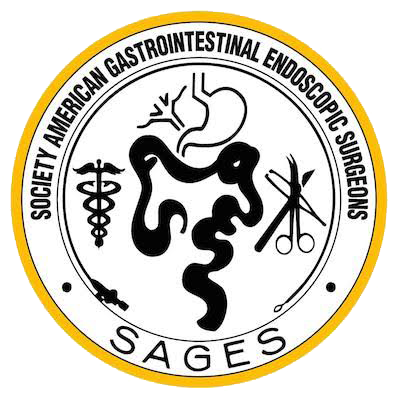There are a number of bands available (The Swedish and the Lap-Band are the most common). I routinely use only the Lap Band because of its durability and low erosion rate. Almost all operations are now performed laparoscopically. Gastric banding is completely reversible and any complications that arise in the long term can be dealt with through keyhole surgery with minimal complications.
The LAP-BAND® System is a clinically proven tool to aid with long-term weight loss. Studies have shown an average excess weight loss of 47.1% maintained at 15 years compared to gastric bypass 54%EWL. The patients either have complete control or improvement in obesity related diseases such as type 2 diabetes, sleep apnoea, heart disease, asthma and hypertension, among others.
The need for revision decreased as the technique evolved, with 40% revision rate for proximal gastric enlargements in the first 10 years with perigastric technique, reducing to 6.4% in the past 5 years with pars flaccida approach. However, in recent years less gastric band are being inserted as the market is driven by the sleeve gastrectomy surgery. This is not to say that gastric banding surgery is not an option for you.
Is it effective?
The weight loss with this procedure has been shown to be comparable to the best weight loss reported with alternative surgical procedures. Patients have lost an average of 58% of their excess weight in one year. Patients who have had the gastric band on for two years have lost an average of 64.8% of the excess weight. Failure to lose weight can occur and is usually due to inability of the patient to comply with their dietary instructions, or in some cases to intolerance in 20 to 30% of patients.
Is it adjustable?
The gastric band has an inflatable section which is connected by tubing to an injectable reservoir. The reservoir will be located below the left rib cage and buried in the abdominal wall. The inflatable section will enable the surgeon to adjust the size of the opening after surgery to ensure it continues providing optimum weight loss results by inserting a needle through the skin to remove or inject saline.
Is it reversible?
Unlike other weight loss procedures, the gastric band procedure is reversible. It does not involve removing or stapling parts of the stomach and does not reroute the digestive tract.

The LAP-BAND® is placed around the top of the stomach.
During the 30-45minute laparoscopic procedure, the LAP-BAND® is placed around the top of the stomach; this applies a constant, gentle pressure, and increases a feeling of satiety (a feeling of fullness) on a smaller amount of food, therefore patients eat less.
Attached to the LAP-BAND® is an access port. The access port sits beneath the skin on the abdomen, and allows the LAP-BAND® to be adjusted to the patients’ individual needs. For optimal weight loss, we work with you on a regular basis to ensure you are in the ‘Green Zone’. These adjustments do not require any additional surgery, and are done in our clinic, usually taking only a few minutes
The stomach is not modified surgically so it is possible to revert back to the normal anatomy at any time by laparoscopically removing the band.
To make the band work in an optimal way patients should eat small meals and aim for only 3 meals a day. They should have small mouthfuls of food, chew thoroughly for at least 20 times before swallowing the content. They should allow for 60 seconds after swallowing to allow the food bolus to pass through the band before starting the next mouthful. To keep eating before the pouch has emptied causes overfilling of the pouch and oesophagus leading to acute retro-sternal chest pain, excessive vomiting and regurgitation. Persistent over eating will in the Long term cause pouch enlargement and oesophageal dilatation. At this point most patient will suffer symptoms of reflux disease. Heart burn, Nocturnal coughing, regurgitation and aspiration pneumonia are common symptoms. This can usually be fix by removing some fluid from the band or reposition the band. This is the most common reasons for patients to undergo further surgery to reposition the band higher to convert to gastric sleeve surgery.
The golden rules as regarding correct eating techniques are as follows:
- Eat only when you are hungry-about three small meals a day
- Eat slowly chew well
- Stop eating as soon as you feel full
- Do not eat between meals
- Eat only high quality food
- Avoid fibrous food
- Drink enough fluid during the day.
- Drink low calorie liquids
- Be active
Questions and other information about Lap band
-
Advantages of gastric banding
- Least invasive approach
- No stomach stapling or cutting, or intestinal rerouting
- Adjustable
- Reversible
- Lowest operative complication rate
- Lowest mortality rate
- Low malnutrition risk
-
Disadvantages of gatric banding
- Slower initial and long term weight loss than gastric sleeve or bypass
- Regular follow-up for band adjustment critical for optimal results
- Can erode or slip requiring revision
- Can produce vomiting and reflux
- Outcome depends on patient
-
Your surgeon may recommend the LAP-BAND System if you meet the BMI criteria
( This is only a guildline and the ultimate decision for surgery is made by the surgeon)
- Your BMI is at least 35kg/m2
- Your BMI is at least 30kg/m2 and you are suffering from serious health problems (Diabetes, HT, Arthritis etc ) that would be helped by weight reduction
- Are at least 14 years old
- Have a history of being overweight for more than 5yrs
- Have made serious attempts to lose weight but have had only short-term success
- Do not have any other disease that could have caused you to be overweight
- Are prepared to attend regular follow-up sessions and make changes in your lifestyle
- Do not drink alcohol in excess
-
Post-Operative Period
- Hospital stay 1 Days
- Post-operative diet – 2 weeks fluid, 2 weeks puree, 2 weeks soft food
- Keep dressings intact 10 days
- Return to work 3 to 7 days
- Can drive 1 week
- Full exercise in 6 weeks
- Return for first adjustment 4-6 weeks
-
The Band Adjustment Process
- Commences 6 weeks post-op
- Only adjust if hungry and not losing weight
- Not possible to immediately adjust to the band to the optimal volume
- The band is adjusted initially by injecting 1.5cc of saline
- Subsequent adjustments are of 0.5 to 1cc are made until the patient experiences early satiety and appetite suppression
-
Adjusting to Your New Life With the LAP-BAND System
- You will feel more satisfied with a small amount of food
- Our healthcare team will help you learn to eat small, nutritious meals
- You should not be restricted to fluids and should not regurgitate or experience severe heartburn
- You should still be able to enjoy meals and eating out with family and friends—you just won’t eat as much as you once did
- As you lose weight and are able to move around better
- From time to time, your band may need to be adjusted to optimize weight loss
-
What are the possible complications?
Complications
- Gastric perforation
- Haemorrhage requiring open surgery
- Perforation of the stomach by lap instrument
- Perforation of the colon by lap instrument
- Obstruction requiring revision
Minor complications
- Tearing of the spleen
- Damage to the band causing leaks
In the postoperative period
- Pulmonary embolism
- Infection requiring removal of band or port
Long term problems and complications
- Failure to lo se expected amount of weight due to non compliance
- Heartburn and reflux
- Slippage of the band or pouch stretching requiring repositioning
- Erosion of the band into the stomach requiring removal
- Failure of the lap band
- Anaemia
- Oesophageal dysfunction
-
Additional Notes
- Lap Banding is the simplest and safest procedure available for the management of morbid obesity.
- It has been used in a large number of cases world wide with good weight control and improvement of co-morbidities.
- It indicated in patients with a morbid obesity problem who have failed genuine and prolonged attempts at conservative management of their obesity
- It does require patient compliance in adopting dietary changes, eating disciplines and involvement in an exercise regime.
Explore other weight loss procedures
Calculate your BMI
The Body Mass Index (BMI) is a measure for human body shape based on an individual's height and weight.
Contact us today to arrange a private consultation and discuss your options.
Book your appointmentServices
Locations

